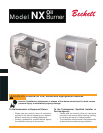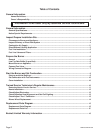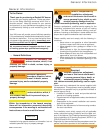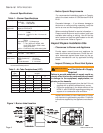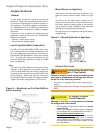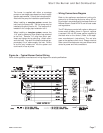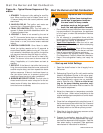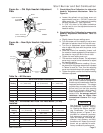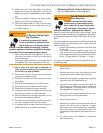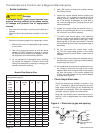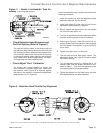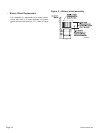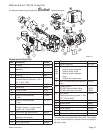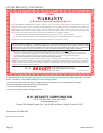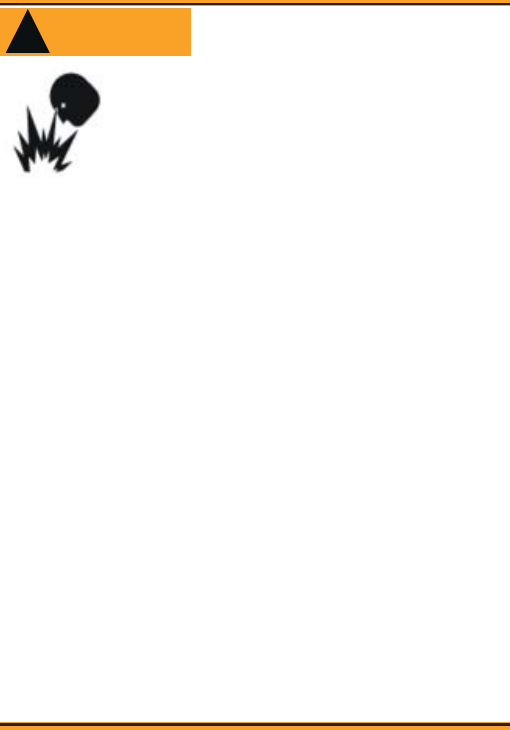
Page 10 RWB 6104 BNX R02
Set Combustion with Test Instruments
Allow the burner to run for approximately 5 to 10
minutes.
Set the stack or over-fi re draft to the level speci-
fi ed by the appliance manufacturer.
Natural Draft Applications; typically over-fi re
draft is -0.01” or -0.02” w.c.
Direct Venting; typically may not require draft
adjustment.
High Effi ciency/Positive Pressure Appliances;
also vary from traditional appliances (see manu-
facturer’s recommendations).
Follow these fi ve steps to properly adjust the
burner:
Step 1: Adjust the head/air until a trace of smoke
is achieved. This can be accomplished by turn-
ing the screw on the head/air adjustment plate
assembly to increase air (CCW) or decrease air
(CW).
Step 2: At the trace of smoke level, measure the
CO
2
(or O
2
) . This is the vital reference point for
further adjustments. Example: 13.5% CO
2
(2.6%
O
2
)
Step 3: Increase the air to reduce the CO
2
by 1.5
to 2 percentage points. (O
2
will be increased by
approximately 2.0 to 2.7 percentage points.) Ex-
ample: Reduce CO
2
from 13.5% to 11.5% (2.6%
to 5.3% O
2
).
Step 4: Recheck smoke level. It should be Zero.
This procedure provides a margin of reserve air
to accommodate variable conditions. If the draft
level has changed, recheck the smoke and CO
2
levels and readjust burner, if necessary.
Step 5: Once the combustion has been set, tighten
the lower acorn nut and splined nut on the air ad-
justment assembly. See Figure 5.
Chimney Vent Systems: Install the burner cover
and repeat Steps 2 and 4 above. If CO
2
increas-
es (O
2
decreases), remove the cover and adjust
the air setting so the CO
2
(O
2
) with the cover
installed meets the requirements of Step 3.
Direct Vent Systems with outside air ducted to
burner: Install the burner cover.
Start and stop the burner several times to ensure
satisfactory operation. Test the primary control
and all other appliance safety controls to verify
that they function according to the manufactur-
er’s specifi cations.
Cover Installation
Install the four cover mounting thumb screws in
the cover mounting plate.
Install the cover over the mounting plate while
aligning the side slots with the installed cover
mounting screws.
•
1.
2.
•
•
•
3.
4.
5.
6.
•
1.
2.
Trained Service Technician’s Regular
Maintenance
Trained Service Technician’s Regular Maintenance
The following guidelines are provided for routine
maintenance.
Replace the oil supply line filter. The line filter car-
tridge must be replaced to avoid contamination of
the fuel pump and nozzle.
Inspect the oil supply system. All fittings should
be tight and leak-free. The supply lines should be
free of water, sludge and other restrictions.
Remove and clean the pump strainer if applica-
ble.
Replace the used nozzle with a new nozzle that
conforms to the appliance manufacturer’s speci-
fications.
Clean and inspect the electrodes for damage, re-
placing any that are cracked or chipped.
Check electrode tip settings. Replace electrodes
if tips are rounded.
Inspect the igniter spring contacts.
Clean the cad cell lens surface, if necessary.
Please read and understand the manual supplied with
this equipment. This equipment must be installed, adjust-
ed and put into operation only by a qualifi ed individual or
service agency that is:
Licensed or certifi ed to install and provide technical
service to oil heating systems.
Experienced with all applicable codes, standards and
ordinances.
Responsible for the correct installation and commis-
sion of this equipment.
Skilled in the adjustment of oil burners using combus-
tion test instruments.
The installation must strictly comply with all applicable
codes, authorities having jurisdiction and the latest revi-
sion of the National Fire Protection Association Standard
for the installation of Oil-burning Equipment, NFPA 31 (or
CSA B139 and B140 in Canada).
Regulation by these authorities take precedence over the
general instructions provided in this installation manual.
•
•
•
•
Incorrect installation, adjustment,
and use of this burner could result
in severe personal injury, death, or
substantial property damage from
Professional Service
Required
fi re, carbon monoxide poisoning, soot or explo-
sion.
WARNING
!



